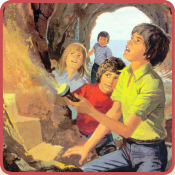
Tales About Toys (Little Book No. 1)

Book Details...
First edition: 1950
Publisher: Brockhampton Press
Illustrator: Jeanne Farrar
Category: Brockhampton Little Books
Genre: Fantasy
Type: Short Story Series Books
Publisher: Brockhampton Press
Illustrator: Jeanne Farrar
Category: Brockhampton Little Books
Genre: Fantasy
Type: Short Story Series Books
On This Page...
- Sheila's Dolls' House
Story: Sunny Stories No.352 Apr 20, 1945 - Old Black Face
Story: Sunny Stories No.353 May 4, 1945 - The Clown's Little Trick
Story: Sunny Stories No.364 Oct 5, 1945 - Good Gracious Me!
Story: Sunny Stories No.354 May 18, 1945 - Grandma's Doll
Story: Sunny Stories No.355 Jun 1, 1945

That's right - five reprinted tales are in this lot and the first is about Sheila's dollhouse. Her brother Benny fashioned it so there's plenty of talent on that side of the family, but one day a very spoilt and careless girl called Lula visits the children and after living up to her reputation, the dolls' house is worse for the wear. Never again will Sheila let her play with it but 'never' is a long time and when Lula is confined to bed with an illness, there's a tough decision to make. Lula is desperate to play with the dolls' house again in order to while away the boringness of staying in her room all day? "No way!" is the expected response, but Sheila's a kind-hearted little girl and mother is very pleased when she agrees to lend her beloved house to the invalid. Enid Blyton tales usually end up happily - especially if someone performs a good deed.
In the second story a strange-looking doll arrives at the nursery. He's black, and as coloured people weren't so numerous in 1940's Britain (when the story first saw light of day) the toys are a little wary. Admittedly, golliwogs have been accepted from Year One, but a doll? Now that's different ... one has to be careful! The toys take an instant dislike to this unusual looking newcomer whose name is Sambo - "That's what all black dolls are called," he tells them. Despite that, the toys decide to call him 'Old Black Face,' a title that reflects the disdain they hold for him. Well, he can't help being manufactured thus, however, in order to please everyone, he tries washing the blackness out of his face but to no avail. The toys are horrible to him and the golden-haired doll even turns her back whenever he tries to strike up a conversation. Teddy bears are known to be jovial but not the one in this nursery apparently - he makes it known that Sambo is simply not welcome full stop! It's all very unfortunate because Sambo is actually a friendly little fellow who loves to laugh and tell jokes. As fate would have it, something disastrous happens, and later the following passage says it all: "The toys looked at him. For the first time they saw the kindness in that little black face. They saw the tiredness too, and the loneliness." Could a happy ending be imminent?
There's usually a clown in an Enid Blyton nursery and sure enough John owns one, plus a clockwork mouse, a rocking horse, a teddy, a fat little elephant and even a Scottie dog - judging by the illustration. Everything's fine except for one thing, it appears that someone is helping himself to John's sweets each night. The boy had put what was left of his chocolates into the nursery bookcase but his action hadn't gone unnoticed and now the boy's angry to see his chocolate supply diminishing quite rapidly. He threatens to lock the cupboard at night so that no one can get up to any mischief, and that's a serious threat because the toys love coming out after hours to mingle and play games with each other. Obviously something has to be done and seeing no one's owned up the clown falls back on a trick - the principle of which Enid Blyton has used before and we can't help feeling that it might just work again.
There's 'Good Gracious, Bruiny' in The Holiday Book, and 'Good Gracious Santa Claus' in The Bluebell Story Book, and 'Good Gracious Me' in this collection. Leslie is the star and he wishes he could save up enough money to buy a hooter for his scooter; after all sometimes he goes almost as fast as a motor-car and he really needs something to warn people he's racing through. One day Leslie's propelling himself through the woods when someone rushes past him. Could this be the 'Good Gracious' part because this person has the longest legs Leslie's ever seen? He's also got a big head with pointed ears and that factor alone is something to say 'Good Gracious' to. Of course we know it has to be a gnome or pixie because pointed ears are always a giveaway. Three small goblin-like men suddenly appear on the scene and Leslie observes they are chasing the pixie - but no way would you catch a leggy person like that without a vehicle so 'Glory Be' (or Good Gracious), Leslie's scooter is commandeered! Naturally the boy doesn't want to let go of his pride and joy but he has no choice because the men simply clamber on and there's the boy and three goblins all pushing away with their feet to make the scooter go faster and faster. Leslie will never forget that frantic chase and the marvellous thing that happened as a result of it. He's also been to Fairyland.
The name Tabitha Jane might sound rather old-fashioned and if so, the reason is that it belongs to Winnie's Grandma's old doll. The girl loves to play with it whenever she visits, and true to the doll's vintage it has china parts and although this detracts from the cuddliness, what Winnie most likes about it is that when she pulls a string in the doll's back, out comes "Mamma, Mamma!" Winnie would very much like to possess the lovely doll but Grandma is keeping it because, " ... it once did a very fine thing ... so she's special." What was the 'fine thing?' This is the question that immediately comes to mind but Grandma will not tell anyone now because when she related the incident to her friends many years ago, no one believed her. Surely the secret will be shared because it'd be unbearable if the story ended with no revelation. Winnie insists on knowing what happened and after promising she will truly believe Grandma's tale, the secret is told and proves to be just a little spooky. The good news is that if ever Grandma gives away the doll, Winnie will get it.
These tales spring from the Sunny Stories magazine. Enid Blyton's book count is suitably impressive but one needs to remember that scores are simply compilations from other collections. ... Dean, Collins, Arthur Barker, Sampson Low, and many more.
#1:
Benny's work of art could indicate that he will, one day, become a skilled carpenter.
#2:
The toys' approach towards Sambo somewhat mirrors the attitude of various groups towards darker people - especially some years back. Like the nursery toys, humans can be fickle in their likes and dislikes.
A Story Party at Green Hedges lists 'The Little Black Doll' and it runs more-or-less along the lines of 'Old Black Face.' Sambo's statement about his name could be correct because the Story Party at Green Hedges doll is also called 'Sambo,' not to mention 'Foolish Little Sambo' in The Fifth Holiday Book. More confusion: 'The Little Black Doll' storyline in E.B's Jolly Story Book is similar to 'The Little Black Doll' in A Story Party at Green Hedges but has a different ending. Trivia: The tale that follows in The Jolly Story Book is 'Hallo, Sooty Face!' Could there be an obsession?
#3:
Page #25 contains a colourful picture of the chocolate thief in action.
#4:
Leslie must have been riding his scooter in 'slow' mode' when the long-legged pixie rushed past him.
There are one or two Blyton stories with fairies or pixies that employ the use of a child's vehicle. In 'The Yellow Motor Car' a brownie King, no less, borrows Brian's car to attend the Pixie's Ball (Poppy Story Book ... and the apostrophe is as printed). 'The Lost Motor-Car' originally belonged to George who left his toy outside one day whereupon some pixies commandeered it to deliver their bakery products (My Enid Blyton Book_1950).
#5:
Winnie's grandma has a sister called 'Mary.'
Confusion continues. The series of Little Books is a different lot from Evans Brothers Enid Blyton's Little Books, the distinction being that this book is entitled Enid Blyton 'Little' Book No. 1 as opposed to Evans's Enid Blyton's Little Books No.1 (spot the difference).
Jeanne Farrar's illustrations seem to fit the Enid Blyton mould very satisfactorily.
There are eighteen in the series and all are worth collecting because they're small, have good pictures, are similarly sized, and are mainly in colour, which isn't all that prevalent in EB books. The Fabulously Famous 'Noddy' is in colour of course.







 Book 1 of 18 in this category
Book 1 of 18 in this category 